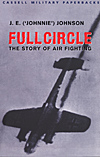 Cassell, 2001, $9.95, ISBN 0-304-35860-6, 290 pages, trade paperback
Cassell, 2001, $9.95, ISBN 0-304-35860-6, 290 pages, trade paperback
This reprint of Air Marshal Johnson’s 1964 book follows the development of air combat from WWI to Korea, with most of the text concentrating on WWII. Johnson, the top Allied ace of WWII with 38 victories, contends that fighter combat has come “full circle” form the lone-wolf days of WWI to the increasing formation flying of WWII, to the more dispersed flights of Korea, to the pairs flying of the time of book publication in 1964.
Air-to-ground operations are covered in detail, from primitive strafing and hand grenade tossing of WWI to much more orderly tactics of WWII. Ground attack, pioneered by the Luftwaffe, received a re-awakening on the Allied side in the North African desert, practical work in Italy, and execution bordering on perfection in Normandy. Toss in the differences between western and eastern fronts and you start understanding its capabilities.
Night fighting is well done, with hesitant steps taken against WWI Zeppelin raids by the British morphing into the sophisticated defenses organized by the Germans against RAF Bomber Command in WWII.
As piston-driven aircraft gave way to jets, the huge formations of WWII were superceded by low-density Korean War flights. RAF Fighter Command often concentrated a ‘Balbo’ of four or five squadrons against the Luftwaffe during the Battle of Britain. The USAAF threw thousand bomber raids against Germany.
In Korea, jet fighters flew in finger four formations, not the 36-fighter wings of WWII. Increased speed and a wider turning radius were the main reasons. In operations at the Yalu River, leaders could not hold even half that number together since running speed and fuel consumption were high and full capacity and greater speed weren’t available to reform a large formation if a plane or two fell behind or became involved in a dogfight. Thus four jets at a time was the unit of choice.
Johnson’s narrative cuts out on the eve of the Vietnam War, although he makes mention of missile range increasing the danger of ‘large’ formations, so that the pair becomes the formation of choice.
The book is a pleasant enough read, filled with anecdotes of air battles and good descriptions of tactics. As a survey, it covers all the bases except for WWII Pacific--little is said about carrier operations. It’s best at the Battle of Britain, which is only natural given Johnson’s role and experience. Indeed, pair Full Circle with Price’s War in the Fourth Dimension and you’ll have an excellent working knowledge of air combat in the 20th century.
Back to List of Book Reviews: World War II
Back to Master List of Book Reviews
Back to Master Magazine List
© Copyright 2001 by Coalition Web, Inc.
This article appears in MagWeb (Magazine Web) on the Internet World Wide Web.
Other military history articles and gaming articles are available at http://www.magweb.com